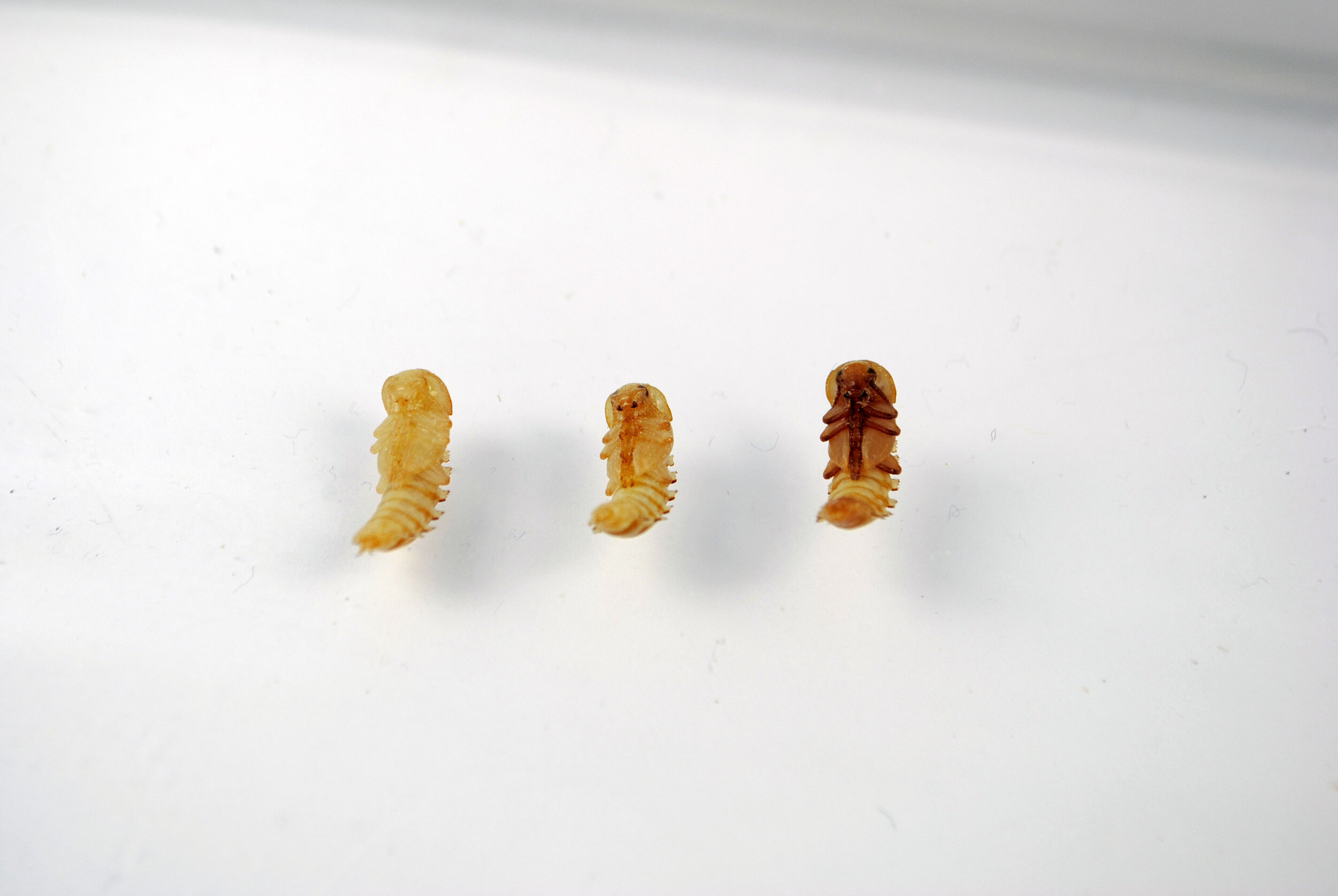Proposal
A Million Meals- Senior Studio Proposal
Background
In 2015, Stanford conducted a study observing the larvae of meal moths and darkling beetles, known as waxworms and mealworms, and their ability to digest plastic. The study showed that unlike cockroaches, who can also eat plastic, that their gut microbes are more complicated, and allow the plastic to be fully digested. The waxworms were able to consume polyethylene film, such as plastic garbage bags, and mealworms consumed styrofoam and other polyethylene products. The waste of the waxworms and mealworms was biodegradable and suitable for compost, whereas that of the cockroaches still contained plastic particles. This study has provided groundbreaking news: plastic can be degraded. Stanford furthered their research by conducting a new experiment studying the main variable, the microbes inside the larval digestive tract. In this study, the scientists administered antibiotics to the larva which inhibited their ability to digest the plastic. This study proved that it is specifically the microbes Enterobacter asburiae YT1 and Bacillus sp. YP1 inside the gut of the mealworm which provides them the ability to digest the plastic. The larval health remained unchanged and indistinguishable from mealworms and waxworms that did not eat plastic. Some even chose the plastic over the typical nutrient food. Currently, the same scientists are furthering their research by studying if the toxins from plastic which leach into water or bind to the fatty tissue of animals still magnify up the foodchain or if the microbes are eradicating them altogether. If this is found to be true, it will have huge impacts, showing we can utilize these insects for both waste clean up and as a food source.
Topic Area
We were all taught plastic takes “one million years” to degrade normally. This study proves that through certain conditions this length of time can be shortened. I’m interested in further studying insects and finding design applications for them. Insects are one of the least studied fields of science and there’s much we don’t know. This study has shown that there are animals present in nature that can do more than what we have initially thought, or given them credit for. Yet insects remain a fundamental building block in the food chain and impact everyone’s daily lives, acknowledged or not.
There haves been no attempts to utilize these findings on an industrial scale. It help increase the recycling content which is currently only at 31% for plastics. It could also radically change our conception of recycling and our current methods. I can see the future having large scale recycling facilities which utilizes insects.
Design and Science go hand in hand. Both demand in depth research, speculating, surveying, hypothesizing, implementing, testing, revising, and repeating.
Proposal
My senior studio will be comprised of research, science lab, and system design studio. Over wintersession I will complete my preparatory research, answering questions such as what insects can consume what, what’s the habitat, what will the experiment set-up be. My final deliverable will be a research essay stating my findings, hypothesis, necessary materials, and procedure for the experiment. In the beginning of Spring I will jump right in and gather all necessary materials and begin constructing the lab set up as laid out in the research paper. The experiment will run from Feb. 27th to May 3rd in the Nature Lab and data will be collected multiple times each week. The experiment is crucial because I am a hands-on learner and observer, my experiment will differ from the Stanford study, this specific topic is understudied so my research will contribute, and the end design will remain hypothetical if my research is superficial. The design proponent is a system redesign of a city’s municipal waste stream, for any state, not necessarily for RI. I plan on challenging the current methods of collection, expansion of areas of collection, improvement of facilities, implementation of insect recycling facilities, proposing changes in environmental law, providing better garbage bins and in more abundance, expansion of national protected land, increase in clean up projects, and clarification to the public about how to properly recycle. The design project could expand into the food industry as well if the Stanford study shows that the plastic toxins do not magnify up the food chain. The final outcome for my project will be a small scale pilot program of an insect waste facility with potential to expand into the city’s municipal waste system. The future of this program would have many facilities in each state and the plastic waste would be shipped to the location for degradation. Output from the mealworms would be their compostable waste turned into fertilizer.
Major Due Dates
Jan. 3rd: Wintersession Begins
Feb. 6th: Research Essay Due
Feb. 7th - 14th: Wintersession Break
Feb. 15h: Spring Semester Begins
Feb. 27th: Experiment Begins
March 6h: Field Trip to- Resource Recovery
March 8th: Mini-Report #1
March 9th/12th: Field Trip to- Warwick Sanitation & Recycling
March 13th: Mini-Report #2
March 20th: Meeting with Providence Office of Sustainability.
March 22nd: Mini-Report #3
April 3rd: Mini-Report #4
April 5th: Field Trip to- MassRecycle
April 10th: Mini-Report #5
April 12th: Field Trip to- Waste Management
April 17th: Mini-Report #6
May 3rd: Conclude Experiment
May 8th: Mini-Report #7
May 10th: Final Written Report Due
May 24th: Crit Day. Last Day of Class.
Grading:
Write-ups/Journal/Data Collection- 40%
Final Design Proposal/Model & Science Report- 20%
Mini Reports- 10%
Preliminary Research Essay- 10%
Evidence of Interest:
On a personal interest level, fun for me as a kid was making a mud puddle in my mom’s garden and digging for worms. I had a kid scientist bug jar which I used to house ants, moths, frogs, and more and keep as pets. At one point I upgraded to an ant farm; I collected ants from my closet rather than ordering them from the company. This curiosity of nature has always remained a part of me. I went on to taking four different biology classes in highschool. Instead of studying Environmental Sustainability I chose to use my art background and study Industrial Design because I was interested in the implementation of design solutions more than testing soil for pollutants (which we can all assume are there). Nonetheless, biology has still remained an influencing factor and source of inspiration for nearly all my projects.
As an NCSS Concentrator at RISD, I feel I’ve utilized the curriculum offerings on these topics of interest. I’ve studied noise pollution in Global Environmental Change, worked with bioplastics and mycelium in Natural Materials, studied biodiversity in Guyana for Wintersession, and presented on the Great Pacific Garbage Patch in History of ID (and more). I’ve taken Biomimicry workshops, entered in the Biomimicry Challenge in 2016, began the Biomimicry Club at RISD. Taking Intro to Insect Morphology was a pivotal class which brought me back to my childhood roots. I’m currently in Environmental Disasters studying environmental law for my final project and plan to propose a tax on corporations for their pollution to encourage a switch to compostable materials.
As a designer, I’m interested in system design, biotech, and material science. I’m drawn to large problems like waste streams and finite energy in attempts to close the loop and reinvent the way humans recycle or consume. I believe the Plastic Problem (and how we get rid of it) is one of the most abundant and prevalent crises today. Most of my design has involved plastic in some way whether I study it, avoid it, or create alternatives, plastic remains a fascination. I have not yet studied the degradation of plastic.
Sources:
http://pubs.acs.org/doi/abs/10.1021/acs.est.5b02663
http://pubs.acs.org/doi/abs/10.1021/es504038a?journalCode=esthag
http://www.cnn.com/2015/09/30/us/styrofoam-eating-mealworms-plastic-waste/index.html
http://www.iflscience.com/environment/plastic-eating-mealworms-could-help-reduce-landfill-waste/
https://www.scribd.com/document/317834309/SIP-PRELIM-PAGES-FINAL-pdf
https://www.lcps.org/cms/lib4/VA01000195/Centricity/Domain/27/1300%20Environmental%20Engineering.pdf
https://news.stanford.edu/pr/2015/pr-worms-digest-plastics-092915.html
https://www.epa.gov/sites/production/files/2016-11/middleofpagemswimage2014.jpg
https://www.warwickri.gov/sanitation-recycling
http://www.providenceri.gov/sustainability/
https://www.wm.com/recycling-services/home.jsp


